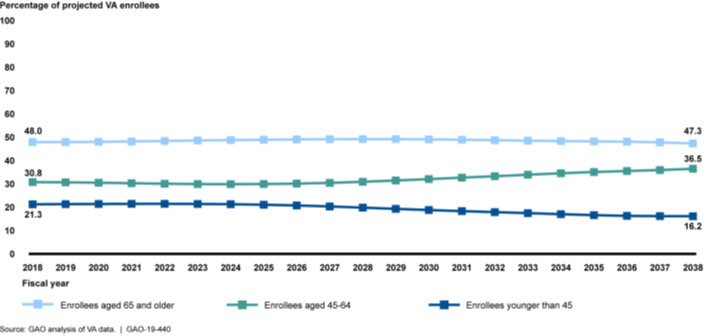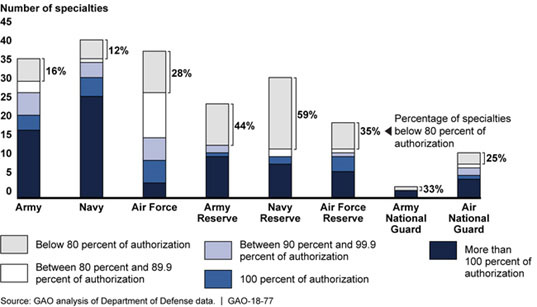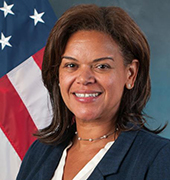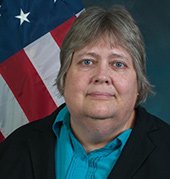
VA and DOD Health Care Management
VA and the DOD have faced a number of challenges with how they manage their health care programs.
Program administration
The VA’s Veterans Health Administration (VHA) provides medical care to millions of veterans every year. It uses 18 regional networks to manage its 172 medical centers. However, VHA does not ensure its networks have the appropriate staff in place to effectively operate the network and to ensure medical centers are providing timely access to quality care. VHA needs to develop a process for ensuring that these regional networks are functioning as intended, including clearly defining roles and responsibilities for managing and overseeing medical centers.
VA also provides medical services to a veteran population that is growing older and more diverse. These demographic shifts will drive changes in veterans’ needs and expectations, and require adjustments to VA medical facilities. However, VA is not fully assessing veterans' changing expectations when it plans for such adjustments. Local VA planners also do not fully trust or use VA estimates on future space needs for their medical facilities.
VA’s Projected Demographic Changes among VA Enrollees (FYs 2018-2038)

Additionally, about 9.6 million beneficiaries are eligible for health care from DOD medical treatment facilities and TRICARE civilian providers. DOD issued a plan in February for a required restructure of medical treatment facilities, which called for decreasing capability at 43 of them and closing five. DOD’s restructuring review included required elements, such as assessing the adequacy of nearby civilian health care. However, it was based in part on incomplete and inaccurate information and may overstate the adequacy of other available care.
Workforce
Turnover in key occupations threatens VA’s ability to deliver on its mission. For instance, VA’s medical facilities had a vacancy rate of 11% last year, including 24,000 medical and dental jobs. The agency uses multiple strategies to support the hiring and retention of physicians (such as financial incentives and a physician training program), but performs limited monitoring and evaluation of its strategies to achieve its goals.
Additionally, VHA’s credentialing process ensures that the doctors and other health care providers it hires are qualified. The process includes a check on whether a provider has been disciplined by a licensing board. However, VHA hired or retained ineligible providers in some cases because hiring staff overlooked or missed disqualifying information in a national database.
Finally, the military has also had trouble filling a number of physician specialties due to nationwide shortages and other challenges. To help, DOD offers programs and incentives to attract and retain more than 16,000 military physicians. However, DOD needs to develop coordinated strategies across the military services to alleviate physician gaps, improve tracking of medical student data, and develop a method to accurately determine medical education costs.
Number of Military Physician Specialties That Were Below Authorizations, FY 2015

Information technology
The VA is replacing its outdated electronic health record system with a commercial system to better support patient care. VA held several workshops to allow stakeholders—clinicians, staff, and other experts—to weigh in on the configuration of the new software that will help deliver care and administer medication. While VA made its configuration decisions on time, it is assessing the impact of the COVID-19 pandemic on its planned implementation schedule. The VA should effectively communicate with key stakeholders to ensure they are involved in the final decision-making for this system.
The VHA also uses multiple computer applications to support its clinicians and pharmacists in prescribing and dispensing medications. However, pharmacists cannot always efficiently view necessary patient data among VHA medical facilities. In addition, pharmacists cannot transfer prescriptions to other VHA pharmacies or process prescription refills received from other VHA medical facilities through this system.
Other resources
To meet veterans’ needs, VA spends billions each year through the Federal Supply Schedules program—a simplified way to buy goods and services in bulk. The General Services Administration delegates management of part of this program to VA, the largest federal purchaser of medical supplies and services. However, VA is not managing the program efficiently, with delays in awarding contracts, a lack of training for contracting staff, and limited visibility into users’ needs.
Additionally, improper payments—payments that were made in an incorrect amount or should not have been made at all—drive up health care costs. DOD uses a methodology for estimating TRICARE improper payments that is less comprehensive than the methodology used by Medicare. Specifically, DOD only examines the claims performance of the contractors that processed TRICARE claims and does not examine the medical record documentation to verify if sampled payments for services provided to beneficiaries were medically necessary.




